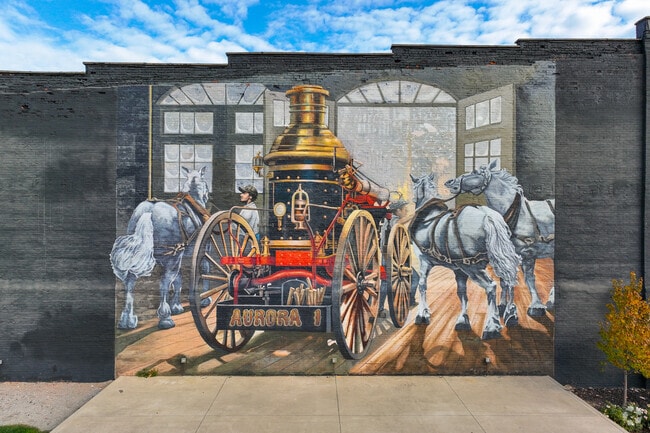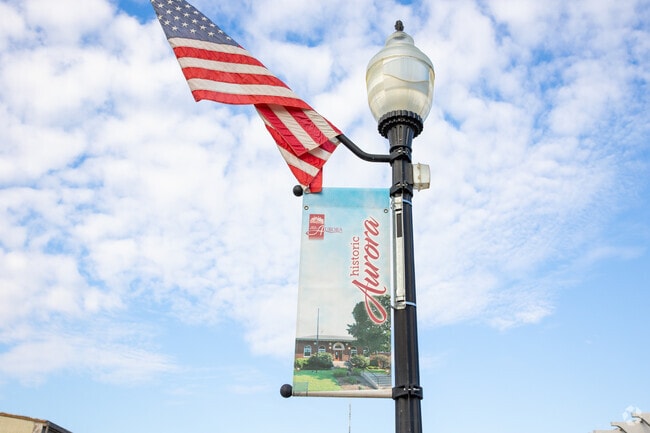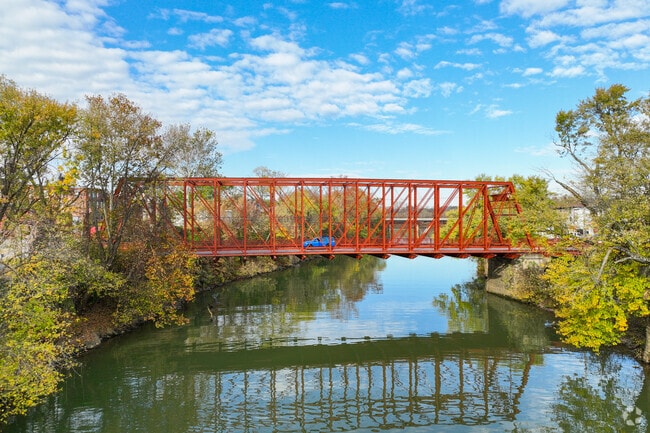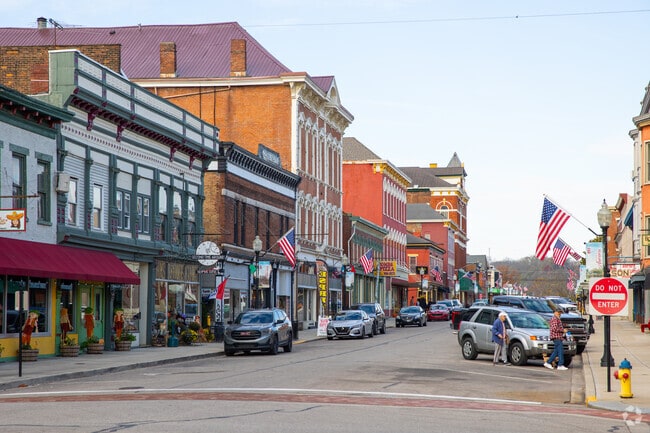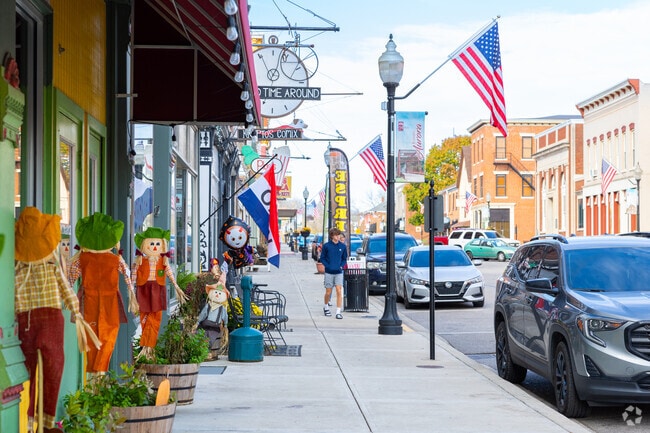Historic riverfront city
Over two centuries ago, folks in Aurora could hear steamboats whistling as they carried cargo to and from the city. At the time, the Ohio River and the potential for a lucrative shipping industry anchored this community. As Aurora grew from the early-to-mid 19th century, folks began to build houses, churches and businesses — many of which still stand tall today. But it's not just the buildings that have remained in the community for years. "There are generations here," says local Realtor Noah Haring with Lohmiller Real Estate. "The house my in-laws live in currently was my wife's great-great grandma's home. It's been in their family since the mid-1800s, and they've made many improvements to it." Similarly, many of the downtown area's eateries and boutiques are housed in renovated historic buildings. This push for rehabilitation is part of why "Indiana's river towns are coming back to life," Haring adds. "In the early 90s, one business was going under, or somebody was moving out. Now everybody wants to be back."
A quaint downtown: Shopping, dining and more
In downtown Aurora, folks can purchase gifts at Lucky Feather Soapery & Mercantile, pick-up vintage treasures at the Second Time Around, or browse collectibles at Kryptos Comix. The community is also home to Weber Sports — A bicycle shop that is also a museum. At Weber's locals can view dozens of bikes from different time periods, including the crowd favorite: a 1950s Donald Duck two-wheeler. For something to eat, Aurora has several cafes and restaurants. Haring recommends Spire Book & Coffee Company known for its cozy atmosphere and Third and Main Restaurant for its steaks. The latter is the only restaurant in the state that dry ages its steaks in-house. For dessert, folks can swing by Wellington's Ice Cream Palace. And for nights out, many locals head to the Great Crescent Brewery. Housed in what was once part of the Gaff Distillery, which came to the community in the 1840s, today, locals head here to meet up with friends, enjoy award-winning beers and honor their city’s rich brewing history. For other options, folks can drive a few minutes outside of the downtown area, where they’ll find many of Aurora’s chain eateries and an Aldi grocery store.
Downtown Aurora Historic District: Notable buildings
In some ways, downtown Aurora looks much like it did over 100 years ago. The old railroad station on Second Street still stands; however, it's since been converted into the Local History Library at The Depot. While residents visit the library to learn about the city, they can still see the ticket window where folks once purchased their train fares. Just down the street is the Aurora Public Library, which features early 1914 Italian Renaissance architecture and was inspired by a Carnegie Library. Nearby, on Fourth Street, the 1850 First Presbyterian Church still stands. Folks who walk past this white Greek Revival structure will see the city's first clock tower, while those who head inside can check out wooden pews that date back to the church’s construction. Just one street over residents can also visit the city's most notable house: the Hillforest Mansion. This large yellow 1850s Italian Renaissance home is now a museum. Its size, circular balcony and belvedere make it stand out from surrounding properties.
No two houses are the same in Aurora
Anchoring downtown Aurora's housing scene are homes dating back to the late 19th-century. Flanking the sidewalks, these properties sit side by side along street fronts and range in style from colorful Victorians with wrap-around front porches to Queen Anne constructions. The downtown area is also home to early 20th-century homes like American Foursquares. The residential scene shifts the further away one gets from downtown, and is replaced with multiacre lots, farmland and densely wooded tree-lined streets, which create a more rural feel. Ranch-styles and farmhouses are particularly prevalent in these areas. Prices typically range between $75,000 to $550,000, depending on the property's condition, size and location. However, "a lot of people aren't selling because of the interest rates," Haring says, "Instead, they're remodeling." Given this, many of Aurora's listings are for land — not homes. While potential development hints at a shifting housing market, "new construction is a slow process," Haring says. It’s important to note that some homes, particularly those near creeks, receive higher-than-average Flood Factor Scores.
Riverfront green spaces
As for recreation, “the river is a big part of life here,” says local Realtor Lorie Eisert with RE/MAX Preferred Choice. “Boating is a big deal — I mean, there are two marinas in town — and apart from that, it’s just nice to look at. The Ohio River is basically part of the town.” Conveniently located, both the Sunset Bay Marina and the Waterways Marina provide access to Hogen Creek, one of the river’s tributaries. For other outdoor options, Haring recommends heading to Lesko Park, which hugs the river and also offers visitors a bike path. Residents are “trying to expand bike trails throughout the state of Indiana,” Haring says. “We’re trying to connect all our river towns.” In the summer, many folks spend time at Aurora City Park, where they can cool off in the pool or host gatherings in the 19th-century octagonal barn.
Aurora Farmers Fair and other events
Much like the rest of the city, the four-day Aurora Farmers Fair has been around for more than a century. It’s held every October and boasts roller coasters, a pie-eating contest and perhaps most notably, a parade, which has everything from bagpipers to decorative floats. When the holiday season rolls around, folks come together for the annual Miracle on Main Street event. Here, locals get in the festive spirit with reindeer, visits from Santa and train rides. Many of Aurora’s other events are held in the warmer months, including Play Music on the Porch Day, where the city invites over 30 musicians and encourages residents to get outside and play their favorite tunes. s.
South Dearborn Community School Corporation
Students here can attend Aurora Elementary, which receives a B-minus rating from Niche and features a number of extracurriculars, including basketball and volleyball. Some students continue playing sports at C-plus-rated South Dearborn Middle, before heading on to B-minus-rated South Dearborn High. At the high school level, students can enroll in business courses. They can also take advantage of career and technical education opportunities.
Commute to downtown Cincinnati and more
Public transportation is not readily available here, so Aurora is a car-dependent area. Haring says that most residents commute to and from Cincinnati for work. The city’s downtown area is just about 30 miles away via Interstate 275 or U.S. Route 50, and it’s home to major employers like Procter & Gamble. Some residents work at local businesses within Aurora, while others drive to nearby communities. One of Dearborn County’s largest employers is St. Elizabeth Dearborn Hospital, which is just under 5 miles away via state Route 48 and Route 50. Locals can take the latter and I-275 to the Cincinnati/Northern Kentucky International Airport, which is just under 20 miles away.
![Marianna Dionysiou]()
Written By
Marianna Dionysiou
![Gabor Kovacs]()
Photography Contributed By
Gabor Kovacs
![Samantha Houtchens]()
Video By
Samantha Houtchens


